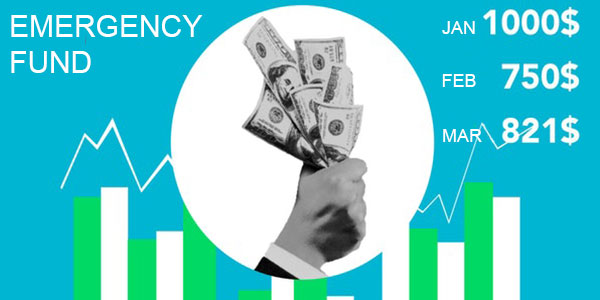How much should you save each month and increase your savings?

It is essential to start saving a significant amount of money from your overall monthly income. But, the question is, how much should you save?
You need to plan for emergencies, retirement, and large expenses. This makes saving an important part of money management.
What percentage of income should go toward your emergency fund?
Before discussing how to build an emergency fund, it’s important to understand what purpose it serves.
How can an emergency fund help?
An emergency, or contingency fund, helps you in emergencies, as the name suggests. It can also be useful in helping you avoid debt.
When facing a medical emergency or an immediate home or car repair, an emergency savings fund can help tackle the situation. As a viable back-up plan, it can help you avoid unnecessary debt on your credit cards. It is also a lifesaver if you face job loss or suffer loss of income.
An emergency fund can also help you pay off debt, especially if you’re facing debt collection calls.
How much should you save in your emergency fund?
You should save an amount that can sustain you for at least six months with a total loss of income. So, you’ll need to spend time figuring out how much you need to keep in your emergency fund.
First, calculate what is required to satisfy all basic needs for one month. Focus only on your and your family’s needs when determining your amount.
Now, multiple this amount by six to come up with your magic number.
While doing the calculations, make sure you consider the rate of inflation.
Try to save at least 10% of your monthly income to your emergency fund. If your financial status doesn’t allow that much, try starting with at least 5%. You can increase the amount as your financial situation improves.
When Pat Saperstein responded to a survey conducted by DebtCC, he said that an emergency fund is an amount rather than a percentage, and it’s strictly for emergencies. He says:
“If you suddenly had to put a new roof on your house, pay a large co-payment for an unexpected medical expense, etc, would you have enough liquid funds available? If you lost your job and unemployment wasn’t enough to fund your expenses, what would you live on?”
“After the pandemic uncertainty, some people feel better having a year’s expenses in cash.”
Jean Chatzsky’s response to the survey indicates that monthly income should be divided as:
- 60% for life expenses
- 20% for long-term savings, including retirement savings
- 10% for short-term savings, such as emergencies
- 10% for fun
Teresa Love says, “I treat my emergency fund like boiling water. I don't touch it unless I absolutely must. I do have sinking funds for things I’m sure I’ll need to purchase.”
According to Erin Shaunfield, “I go off that base 15% and add as much as I can afford. Currently, I’m at 25%. I also make sure I max my tax deferred 401(k) to lower my current tax liability.”
Anytime you have to tap into your emergency fund, you should try to replenish the fund as soon as possible. It will help you remain stress-free, knowing you can handle any financial troubles.
What percentage of income should go towards your retirement savings?
Usually, financial advisers recommend contributing 10% - 15% of your monthly income towards your retirement.
If you can, try to save 15% of your pre-tax income in a retirement account.
If you have a 401k, the ideal contribution is 15% - 20% of your gross income. Try to deposit an amount to get the maximum match from your employer. It will help your retirement fund achieve substantial growth.
According to financial advisers, you should start saving for your retirement from the month you get your first paycheck. Early contributions, along with the help of compounding interest, will help your retirement fund grow. You can also find out how much you need to save if you want to retire early.
However, retirement planning often becomes complicated when you have a debt to pay off. People often wonder whether they should focus on repaying debt or saving for retirement.
We interviewed a few people, and this is what they have to say about emergency funds, retirement funds, and how much to save.
According to Pat Saperstein, “If you want to retire in the next 25 years, you can start by looking at the 4% rule, or multiplying your estimated spending at retirement (minus Social Security) by 25, which will give you a ballpark figure of how much to save.”
Deborah Van Doorne Struening says that the retirement savings rate should be 15% - 20% of gross income. “Where you place your retirement savings depends on a lot of factors: age, tax bracket, accounts available. You might want to consider talking to a financial planner.”
Danielle Lorenz says, “I paid a fee only for an advisor to evaluate my circumstances, goals to establish how much I need to be saving each month into RRSP and TFSA. Generally, I see 15% of your gross income per month as a recommended starting point.”
According to Jeremy Kain, “retirement savings depends on:
- Income
- ASAP (Automated Standard Application for Payments)
- How much money do you want/need per year multiplied by how long you expect to live (plus more).”
Tips on how you can boost your savings
Here are a few tips to increase your savings every month.

- Take advantage of cashback credit cards: If you use credit cards, why not get cashback for your purchases? Extra money always helps to boost your savings. You can add the money to your emergency fund or your retirement account. This could be useful when paying off debts.
- Plan a budget and pay yourself first: The first step to save a decent amount of money every month is to plan a budget. You can use the envelope strategy or the 50-30-20 strategy to plan a budget. You can also go for a counseling session if you can’t create a realistic budget on your own. The budget should be something you can follow without much difficulty if it is going to be successful.
- Take a close look at your retirement savings: Try to increase your 401(k) contribution. By doing so, you’ll also pay less in taxes as you deposit your pre-tax amount into your 401(k) account. About 71% of companies match $.50 for every dollar invested by employees. However, about 21% of companies match employee contributions dollar for dollar. Learn your employer’s 401(k) guidelines to decide how to invest. When starting with a new company, make retirement planning a priority. Financial experts always recommend saving for your retirement from the time you get your first paycheck.
- Open a hybrid checking/savings account: Won’t it be nice if you get the benefits of a savings and checking account together? For instance, the checking account of Radius Bank offers a high rate of interest. You can get the services of a savings account along with the convenience of a checking account altogether. It can help you boost your savings to earn a high rate of interest.
The best way to save money is to manage your expenses so that you don’t fall into debt problems. With significant debt, a large part of your savings will go towards making the interest payments and late penalties.
If you owe creditors, debt management should be your first priority. If required, get professional help and get out of debt as soon as possible. Only then will you be able to save money to build a promising financial future.
